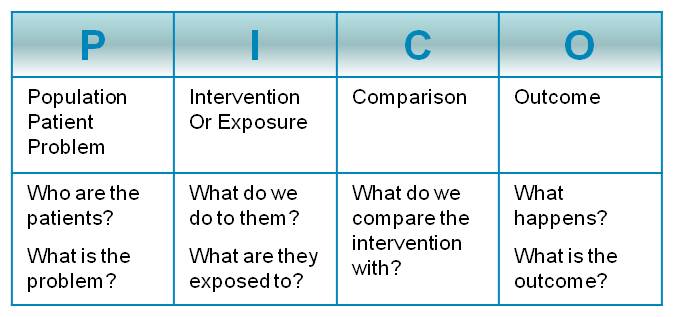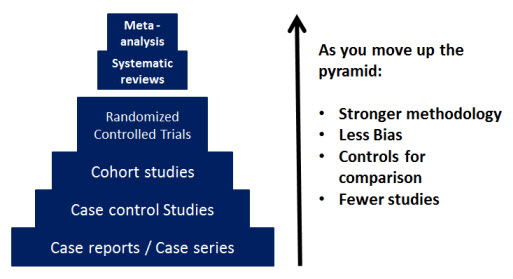- Provide essential information about Evidence-Based Medicine/Practice (EBM/EBP).
- Guide clinicians, practitioners, and students to relevant EBM/EBP resources through the Calder Library.
You may navigate this guide by using the links in the Table of Contents on the left side of the screen, or by using the Tabs at the top of each page.
- Using PubMed in Evidence-Based Practice
- Module 1: Evidence-based Medicine under Evidence Essentials | Cochrane Training

John Usseglio
- Education and Outreach Librarian
- jgu11@med.miami.edu
- (305) 243-5530

Layal Hneiny
- Clinical Research Librarian
- layal.hneiny@miami.edu
- (305) 243-8755
- Email: reference@miami.edu
- Phone: 305-243-6648
- Ask a Librarian: http://calder.med.miami.edu/librarianask.html
Etiology: how to identify causes for disease (including its iatrogenic forms).
Diagnosis: how to select and interpret diagnostic tests, in order to confirm or exclude a diagnosis, based on considering their precision, accuracy, acceptability, expense, safety, etc.
Prognosis: how to estimate our patientâs likely clinical course over time and anticipate likely complications of the disorder.
Therapy: how to select treatments to offer our patients that do more good than harm and that are worth the efforts and costs of using them.
Prevention: how to reduce the chance of disease by identifying and modifying risk factors and how to diagnose disease early by screening.
FROM: User's Guides to the Medical Literature: essentials of evidence-based clinical practice G. Guyatt et al (eds) New York, 2008.
PICO is a useful tool for asking focused clinical questions.

PICO clarifies the question, determines search concepts and type of study that is most appropriate to answer the question type.
P.I.C.O. Model for Clinical Questions
|
P |
Patient, Population, or Problem |
How would I describe a group of patients? |
|
I |
Intervention, Prognostic Factor, or Exposure |
Which main intervention, prognostic factor, |
|
C |
Comparison or Intervention (if appropriate) |
What is the main alternative to compare |
|
O |
Outcome you would like to measure or achieve |
What can I hope to accomplish, measure, |
|
|
What type of question are you asking? |
Diagnosis, Etiology/Harm, Therapy, Prognosis, |
|
|
Type of study you want to find |
What would be the best study design? |
- Oxford University Study Design
This page gives a brief comparison of the advantages and disadvantages of the different types of studies. - Understanding Research Study Designs
In order to find the best possible evidence, it helps to understand the basic designs of research studies. The following basic definitions and examples of clinical research designs follow the “hierarchy of evidence”.
- GRADE Working Group
Grading of Recommendations Assessment, Development and Evaluation (GRADE). The working group has developed a common, sensible and transparent approach to grading quality of evidence and strength of recommendations - Levels of Evidence and Grades of Recommendations
Oxford Centre for Evidence-Based Medicine 2011 Levels of Evidence
Evidence-based practice requires that clinicians search the literature to find answers to their clinical questions. There are literally millions of published reports, journal articles, conference proceedings, and research studies available to clinicians. Choosing the best resource to search is an important decision.
- AccessMedicine
Include's Harrison's Online and Goodman and Gilman's Pharmacology. McGraw-Hill's AccessMedicine.com is an innovative online resource that provides students, residents, clinicians, and researchers with instant answers to clinical questions from the most trusted sources. Updated daily and expanded continuously, Access Medicine is designed for direct access to the information necessary for completing evaluations, diagnoses, case management decisions, conducting research, medical education, or self-assessment and board review. - ClinicalKey
ClinicalKey is a clinical search engine that supports clinical decisions by making it easier to find and apply relevant knowledge. - E-Books available through Calder Library
If you are unable to locate a book on this page, please go to uSearch.
- ACP Journal Club
The content is carefully selected from over 100 clinical journals through reliable application of explicit criteria for scientific merit, flowed by assessment of relevance to medical practice. - BMJ Clinical Evidence
Clinical Evidence describes the best available evidence from systematic review, RCTs, and observational studies when appropriate for assessing the benefits and harms of treatment. - DynaMed
DynaMed is the next-generation clinical reference tool physicians can rely on for fast, easy access to point-of-care decision support. Written by a team of specialized physicians and researchers, content is updated several times daily to include information on the latest evidence-based research, providing practice-changing answers to clinical questions with optimized speed. - UpToDate
Clinical decision support tool designed to answer clinical questions that arise in daily practice. Subscription database with access for UM/JMH authorized users.
- Center for Review and Dissemination (DARE)
Assists decision-makers by identifying and describing systematic reviews and economic evaluations, appraising their quality, and highlighting their relative strengths and weaknesses. - Cochrane Library
Collection of health databases providing independent evidence to inform clinical treatment decisions and other health related decisions. Includes: Cochrane Database of Systematic Reviews, Cochrane Controlled Trials Register, Database of Abstracts of Reviews of Effects, Cochrane Methodology Register, Health Technology Assessment Database and NHS Economic Evaluation Database. - PubMed Clinical Queries
Allows you to quickly focus your PubMed search on clinical studies and systematic reviews. Find out more in our online tutorial.
- Trip Database
The TRIP Database searches across multiple Internet sites for evidence-based content. It covers key medical journals, Cochrane Systematic reviews, clinical guidelines, and other highly relevant sources.
How to Construct a Well-Built Clinical Question (PICO)
Learn from this live Calder Library Training Session the basics of contructing the PICO question.
- The Centre for Evidence-Based Medicine
CEBM.net is a microsite dedicated to the dissemination of evidence reviews about the coronavirus pandemic.
 How to Read a Paper: The Basics of Evidence-Based Medicine
How to Read a Paper: The Basics of Evidence-Based Medicineby Greenhalgh
 Users' Guides to the Medical Literature : A Manual for Evidence-Based Clinical Practice
Users' Guides to the Medical Literature : A Manual for Evidence-Based Clinical Practiceby Guyatt
 Painless Evidence-Based Medicine
Painless Evidence-Based Medicineby Dans, Dans, Silvestre
 Symptom to Diagnosis: An Evidence-Based Guide
Symptom to Diagnosis: An Evidence-Based Guideby Stern, Cifu, Altkorn
 Evidence-Based Physical Diagnosis
Evidence-Based Physical Diagnosisby McGee
 Studying a Study & Testing a Test: Reading Evidence-Based Health Research
Studying a Study & Testing a Test: Reading Evidence-Based Health Researchby Riegelman, Nelson
 Achieving Evidence-Based Practice: A Handbook for Practitioners
Achieving Evidence-Based Practice: A Handbook for Practitionersby Hamer, Collinson
 The Philosophy of Evidence-Based Medicine
The Philosophy of Evidence-Based MedicineHowick
 Evidence-Based Practice Workbook: Bridging the Gap Between Health Care Research and Practice
Evidence-Based Practice Workbook: Bridging the Gap Between Health Care Research and Practiceby Salisbury, Glasziou, Del Mar, Salisbury
- Evidence-Based Practice Overview (4 min.)
- Defining Evidence-Based Practice (4 min.)
- Developing an Evidence-Based Question (1 min.)
- Critical Appraisal (23 sec.)
- Implementing Evidence-Based Practice (3 min.)
- Apply the Findings and Evaluate (2 min.)
- Resources (3 min.)
